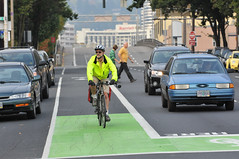
(Photos © J. Maus)
The bike lane on SE Hawthorne Blvd between SE Grand and 12th was widened to six feet as part of a recent repaving project by the Bureau of Transportation.
“The goal is to get to a post-modal approach where we’re looking at uses, context, and the best design on a particular street.”
— Catherine Ciarlo, Transportation Police Director for Mayor Adams
This stretch of Hawthorne is a bike thoroughfare (especially during the evening commute) with thousands of people riding it as they come off the Hawthorne Bridge headed to points east. The new width, along with a similar bike lane widening on N. Williams during a recent re-pave got me thinking: Are these wider lanes the result of a new PBOT policy to make all bike lanes a minimum of six-feet wide? Is this a direct result of the new design policy guidelines included in the 2030 Bike Plan?
To help with those questions, I called Mayor Adams’ Transportation Policy Director Catherine Ciarlo. Ciarlo called the widening, and how it came about, a “perfect example of what we’re trying to do as a city.”
“I think what you’re seeing is an opportunistic approach. We’re looking at places in the city where bike ridership is high and we can reasonably accommodate a wider bike lane without impeding freight and bus travel and without widening the road.”
Ciarlo said the wider lane reflects an understanding within the Bureau of Transportation that, when possible, they’d like people on bikes to be able to comfortably pass slower riders and in some cases ride side-by-side.
Hawthorne in the location is a high-volume arterial street with four travel lanes (three standard lanes and a bicycle-only lane) and two lanes for parking. Ciarlo says a six-foot bike lane was the appropriate facility to design in this context (remember, this was a repaving project, not a bikeway design project).
Ciarlo added that the policies adopted in the 2030 Bike Plan, while not binding law, are helping to push them in the direction of accommodating bikes “as a matter of course.”
“What you see is a real shift in the way the city sees modes… The goal is to get to a post-modal approach where we’re looking at uses, context, and the best design on a particular street.”
This wider bike lane marks an approach by the City to design high demand bikeways beyond the bare minimum. It also shows how, when given the chance, they are allocating more road space to bicycles.
“You take those opportunities and you run with them,” she said, “This thinking is woven into the fabric of the way the transportation bureau thinks.”


